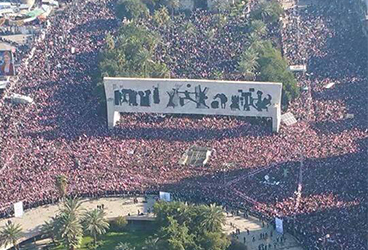Jun 2016

After the events of the revolution of 1958, Prime Minister Qasim asked the architect Rifat Al-Chadirji to build a monument in memory of the establishment of the Republic of Iraq. As the political situation continued to be unstable, demonstrators were still out on the streets with their hand-made slogans. Al Chadirji, influenced by the civilians on the street, decided to install the largest sign possible on the streets of Baghdad; a 50 metre long, 10 metre high monument in the middle of Al Tahrir Square.
Al Chadirji, unable to fulfil such a task on his own, reached out to Jawad Saleem, the highly acclaimed Iraqi sculptor and painter, and requested his help in representing the revolution on a 50 metre long structure. Saleem was surprised by the idea and exclaimed that these kind of sculptures had not been made by anyone since the time of the ancient Assyrians.
Mohammed Ali Hikmat, a student of Saleem describes his side of the story: “In 1959, I received a message from Saleem telling me that he was coming to Rome. At that time I had a small workshop in the Italian capital. Saleem arrived at the studio and started sculpting samples of the monument from clay, starting from the middle by sculpting the figure of the ‘prisoner of thought’. On the right he sculpted the events before the revolution and on the left the events after the revolution.”
After completing the sample, the work started on the full size of the 14 figures that represented the story and the final day of the revolution – the 14th of July. The figures were made of bronze and it took two years to complete the work. However those two years were not easy for Saleem. With no political allegiances Saleem insisted that the work should represent the people rather than political events. There was also a huge amount of pressure on him, as initially he was requested to finish the work within a year – an unrealistic request for such a huge piece. Added to this was Saleem’s own pressure of perfection in his work and soon he fell ill.
In his life, Saleem was heavily influenced by the bass reliefs of Assyrian and Babylonian times, the Post Impressionists, as well as French sculptor Maillol and the British sculptor, Henry Moore. But before he even had the chance to enjoy the finished piece that he gave his all to for so many years, Saleem died of a heart attack. He was undoubtedly the most influential artist in Iraq’s modern art movement.
With the unfinished sculpture still requiring completion Al Chadirji suggested that Lorna Saleem was the only person capable of completing the artwork. Mrs Saleem was a British painter who had met Jawad during his studies in London where they fell in love and got married. She was the perfect person to carry on her husband’s work as they shared a home art studio; she knew and understood his artistic style so intimately. Lorna completed the work according to his perfectionist standards. On finishing the bronze sculpture Lorna Saleem was given Iraqi citizenship for her efforts and contribution.
In 1961 the figures reached Baghdad for placement in Al Tahrir Square. With the absence of both Jawad and Lorna the monument was officially opened on 14 July 1961. The bronze relief on Al Chadirji’s concrete wall is the largest monument to be erected in Iraq in nearly 2500 years.
Meaning of the 14 figures of the monument:
The Freedom Monument is a visual narrative reflecting the Arabic language so it can be ‘read’ from right to left.